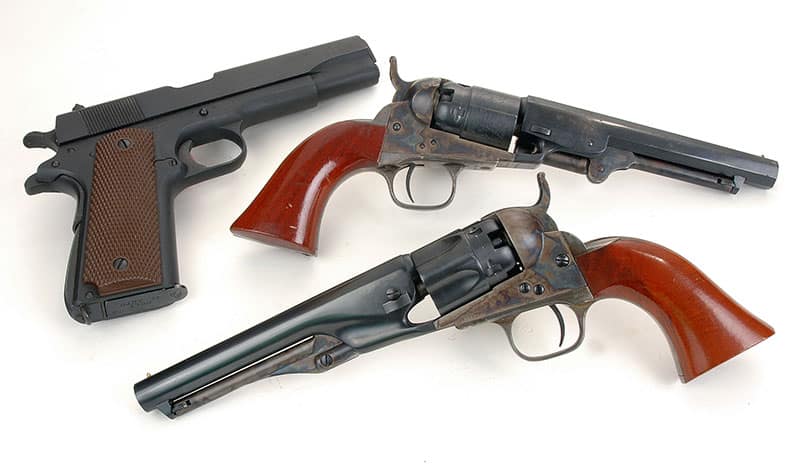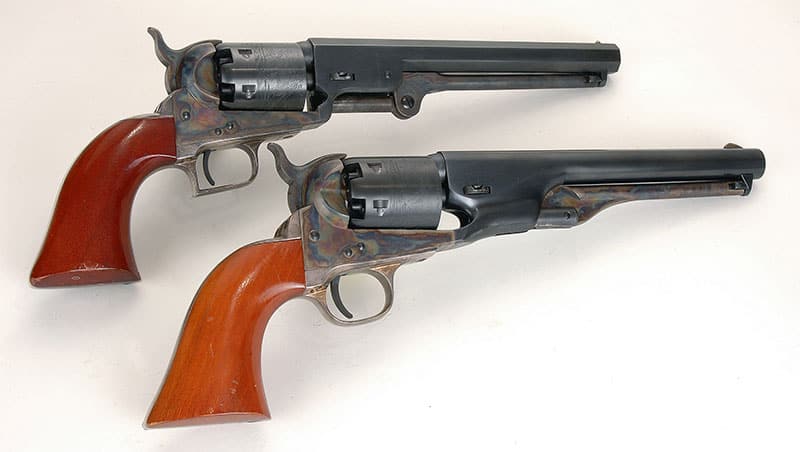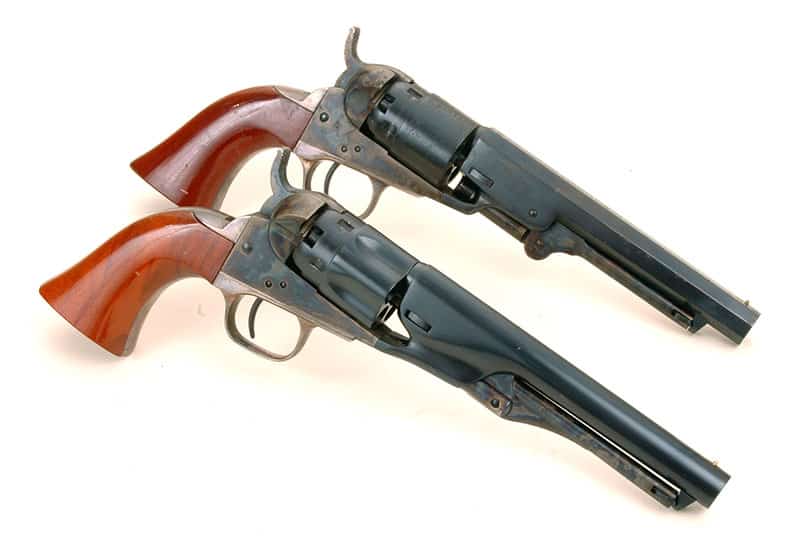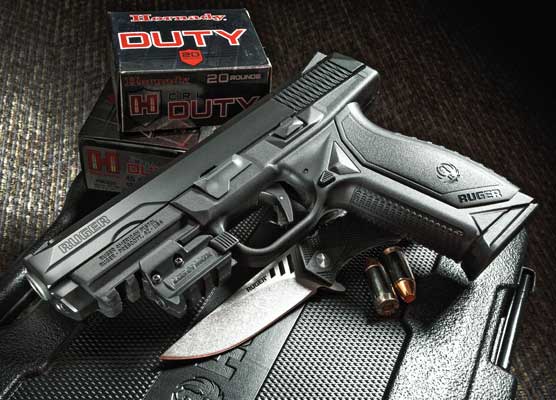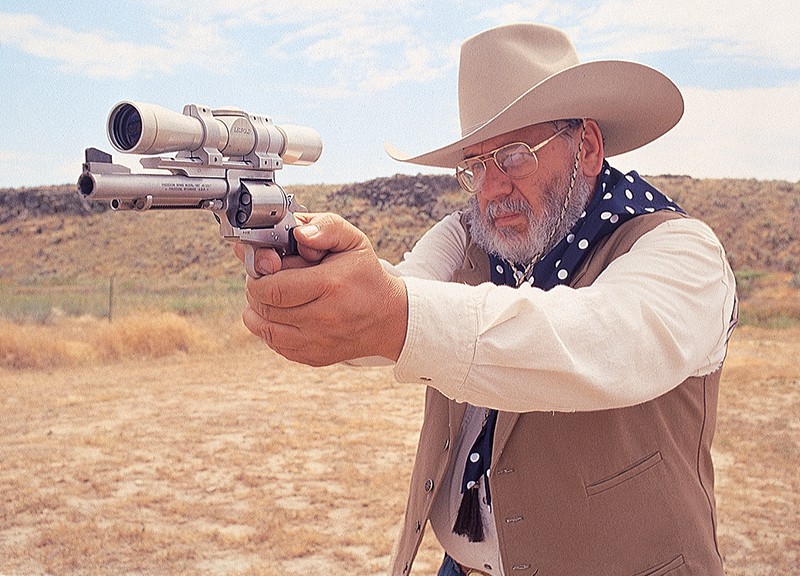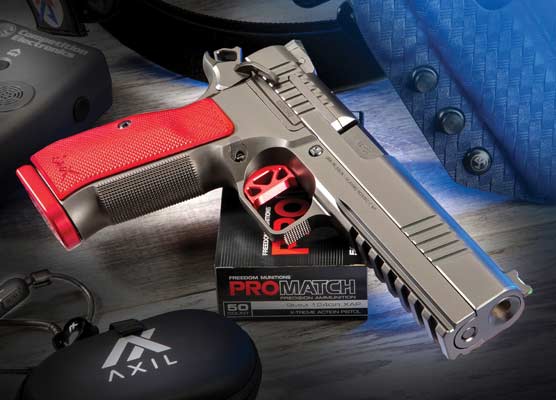COLT’S LAST THREE CAP
& BALL MODELS
Part 6 Of 12 Part Genesis Of The Colt Single Action
We’re going to lump the last three Colt cap and ball revolvers together in one article because they were simply modifications and adaptations of pre-existing models. All three were also .36 calibers.
The streamlined look of the Model 1860 Army .44 was an instant success, so Colt followed it up with a revision of the .36 Navy. This was the Model 1861, and while it does have the gracefully curved barrel contours of the Model 1860 and was likewise based on the Model 1851 frame, it did differ in two significant ways. Because it was of .36 caliber the rebated cylinder concept was not needed, and the quarter-inch longer grip frame was not used again. In fact it was never used again. While looking good it actually offered nothing in shoot-ability. It was the grip frame of the Models 1851 and 1861 with round instead of square back trigger guards that Colt carried on to the cartridge-firing Single Action Army of 1873.
It’s also interesting to note not all handgun buyers of the 1860s preferred gracefulness in their revolvers. The Model 1861 did not replace the Model 1851 with its octagon barrel. Both .36 calibers were produced side by side right up until the discontinuation of all Colt percussion revolvers, circa 1873. One might be excused for thinking the later .36 caliber Navy would be lighter than the earlier .36 caliber Navy due to its smoothly contoured barrel. In actual fact, weighing my 2nd Generation samples shows the ’61 is two ounces heavier than the ’51. As far as effectiveness is concerned there was no change: their powder capacities were the same and both used 7 ½” for barrel length. Hence the 80 grain .375″ diameter round ball could be pushed in excess of 1,000 fps by about 25 grains of Goex FFFg blackpowder.
The Very Last
Colt’s last two percussion revolvers were five-shooters. Collectors have named them Model 1862s, with the one with octagon barrel being called Pocket Navy and the one with contoured barrel called Pocket Police. By this time people carrying concealed revolvers for self defense felt an 80 grain .36 caliber round ball was more effective on an assailant than a 48 grain .323″ round ball. Therefore, the Model 1862s were Colt’s attempt to enhance the power of a pocketsize handgun.
This was done by staying with the small frame of the Model 1949 .31 caliber. To enable the chambers to accommodate .36 caliber balls Colt once again turned to the rebated cylinder concept begun with the Model 1860 Army .44. Why they chose to produce the basic Model 1862 in two different barrel configurations is anyone’s guess. Regardless, barrels for both were 5 ½” long. One might wonder why they were not built with shorter barrels if they indeed were meant for “pocket carry.” The reason is the rammer beneath the barrel.
If substantially shorter it would not provide enough leverage to easily seat balls into chambers. Colt had tried the rammer-less concept before with the Baby Dragoon. Calling that method of reloading a cap and ball revolver slow and difficult is an understatement. Both of my 2nd Generation Model 1862s weigh 28 ounces. Again I thought the Pocket Police version with its contoured barrel would be lighter, especially since it has a fluted cylinder. It was not.
Power?
In trying to ascertain the possible power of the Model 1862s I dispensed with Ox-Yoke Wonder Wads in favor of the old method of grease smeared over the seated ball for sealant and lubrication. In that way 20 grains of Goex FFFg blackpowder fit beneath Hornady 80-grain round balls. My chronograph measured the velocity of that combination as about 850 fps. Such would give the foot pounds of energy of about a .32 Auto pocket pistol of today.
None of the last three Colt .36 caliber revolvers were manufactured in immense numbers. About 38,000 Model 1861s were made and around 48,000 of the Model 1862s with both configurations lumped together by serial numbers.
Throughout this series I’ve made continuous mention of Colt’s 2nd Generation cap and ball revolvers. In my experience-based opinion those are the best of the many types of replica Colts ever made. They are built just as the originals — with inherent design flaws of each model included. Yet they were built of modern steels, so shooting them much (safely!) is not a strain to the revolver.
There are numerous rumors about the heritage of these 2nd Generation Colt percussion handguns. This is the straight scoop. Starting in the 1970s and ending in 1982, raw parts were imported from Italy. Then they were given final machining, fitting, polishing with blue and color case hardening, all done by the now defunct Iver Johnson Company, then located in Arkansas. Only the marketing was done by Colt. Regardless, they are revolvers of superb quality, albeit quality of final finishing with some fell off a bit toward the end of production.
More 2nd Gen
My introduction to the Colt 2nd Generation cap and ball revolvers started in 1980 when Yvonne bought a Model 1860 for my Christmas present. Not too long afterwards I picked up a Model 1851. By the early 1990s I realized prices were going up on all the 2nd Generation Colt percussion revolvers commensurate with numbers produced and individual model’s popularity.
For instance, prices were high on Model 1860s due to that latter factor and also high on the Baby Dragoons because only about 1,500 were made. Lower prices were put on the Model 1862s and 3rd Model Dragoons because they were made in greater numbers, but only in regards to 2nd Generation models. Therefore I set upon a quest for them, and for 15 years now I’ve kept a sample of each basic model in a case on my gun vault’s wall. It shows Colt single action evolution at a glance.
Next time, we’ll take on Colt conversions — which actually weren’t!
Click Here To View List And Links To All Colt Series Articles
